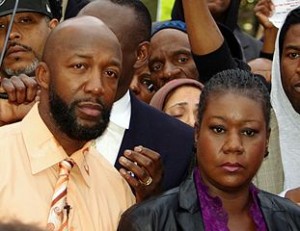
Trayvon Martin’s father and mother. (Credit: David Shankbone/Wikimedia Commons)
For the one-year anniversary of the death of Florida teenager Trayvon Martin, Eric Deggans at Poynter has a piece laying out takeaways from how the media covered the race issues involved in the story. He notes the process of how reporters gradually started to define the heroes and villains of the situation.
Journalists, he says, are driven by social justice imperatives, hoping to add context to their stories with diverse points of view (i.e. journalists of color weighing in on the more metaphysical layers of racial discrimination existent in America). Most of all, he says, publications and reporters hope to be first to print big scoops, evident in how CNN used audio analysis of a 911 call to falsely say that Zimmerman had used a racial slur.
Deggans also discusses a “myth of life” view that reporters sometimes get during these troublesome stories, as if the killing of an unarmed black teenager violates the notions of how people believe life works. According to him, online media perpetuates the “myth of life” approach: “With so few nuggets of news connected to the real questions the audience wants answered, a default for some media outlets can involve talking about ancillary issues, which distract and complicate.”
His conclusion: “In the Martin case, the toughest task journalists may face is ignoring the perceptions and judgments of the outside world to focus on telling the most accurate, incisive stories possible.”








